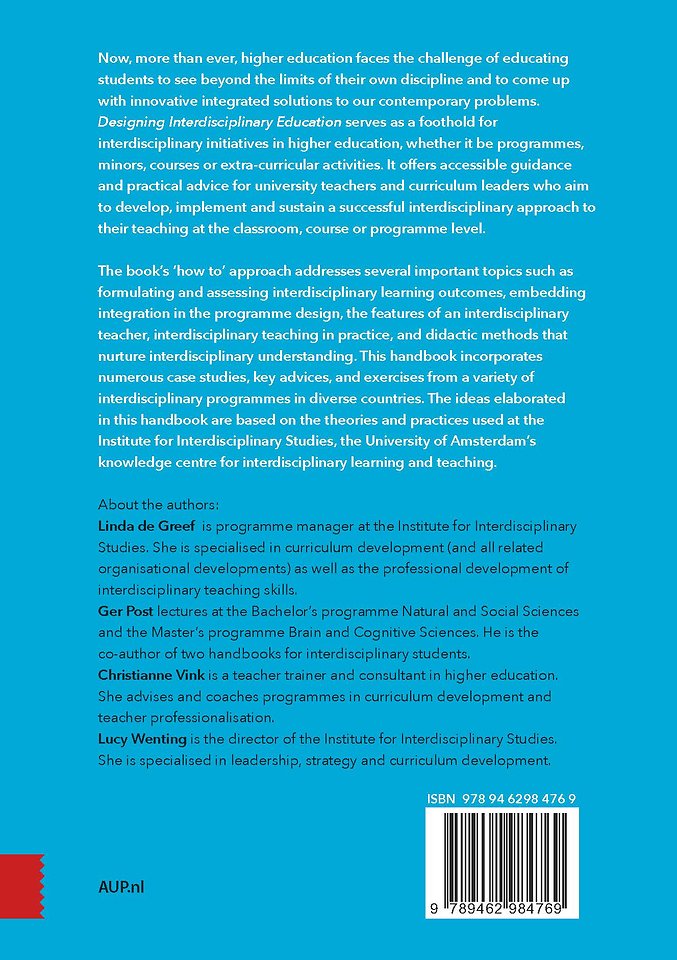Designing Interdisciplinary Education
A Practical Handbook for University Teachers
Samenvatting
Interdisciplinary education has been identified by many educational organisations in Europe and the United States as important for what lies ahead, and it has become a buzzword in some debates about educating for the future. Now, more than ever, higher education is challenged to educate students to see beyond the limits of their own discipline and to come up with innovative integrated solutions for our global challenges. But how do you define interdisciplinarity? How do you measure whether a student has integrated different insights? How do you challenge students to step across disciplinary borders?
'Designing interdisciplinary education' offers guidance and practical advice for university teachers who want to successfully develop, implement and sustain an interdisciplinary approach to their teaching.
Specificaties
Inhoudsopgave
1 Introduction
1.1 Moving towards more complexity
1.2 Why interdisciplinary education?
1.3 Why this handbook
1.4 An overview of the content
2 An overview of the development stages
2.1 Starting with an interdisciplinary development team
2.2 Stages in programme development
2.3 Putting the theory into practice
3 Unravelling interdisciplinary understanding 28
3.1 The definition of interdisciplinarity
3.2 Embedding integration in education
3.3 Unravelling interdisciplinary understanding
4 Developing the raw sketch
4.1 Drafting the vision
4.2 Expressing thevision
4.3 Engaging stakeholders in the visioning process
4.4 Communicating the vision
5 Formulating interdisciplinary learning outcomes
5.1 Intended learning outcomes at the programme level
5.2 Intended learning outcomes at the course level
5.3 Creating learning pathways within a programme
5.4 Translating intended learning outcomes into learning activities
6 Embedding integration in the programme design
6.1 Four curriculum models
6.2 Deciding on a curriculum format
6.3 Working towards an interdisciplinary programme
7 Hiring and engaging faculty
7.1 Features of an interdisciplinary teacher
7.2 Recruiting, engaging and connecting faculty
7.3 Overcome hurdles in the interdisciplinary teaching team
8 Exploring the teaching philosophy and didactic methods
8.1 Assumptions of teaching and understanding
8.2 Formulating a shared teaching philosophy
8.3 Didactic methods that nurture interdisciplinary understanding
9 Assessment of interdisciplinary learning outcomes
9.1 Valid assessment of interdisciplinary learning outcomes
9.2 Make interdisciplinary assessment work
9.3 Developing a programme-wide assessment strategy
10 Interdisciplinary teaching in practice
10.1 Important prerequisites for interdisciplinary classes
10.2 The teacher as coach
10.3 Teaching reflective functioning
10.4 Enhancing collaboration skills
10.5 Teaching critical thinking
10.6 Teaching an integrative interdisciplinary capstone course
11 Programme assessment and adjustment
11.1 Formal and informal assessment
11.2 An evaluation approach
11.3 Accreditation of interdisciplinary programmes
11.4 Sustaining interdisciplinary programmes
Appendices
Index case studies
Index activities
Index key advices
References
Colophon
Net verschenen
Rubrieken
- aanbestedingsrecht
- aansprakelijkheids- en verzekeringsrecht
- accountancy
- algemeen juridisch
- arbeidsrecht
- bank- en effectenrecht
- bestuursrecht
- bouwrecht
- burgerlijk recht en procesrecht
- europees-internationaal recht
- fiscaal recht
- gezondheidsrecht
- insolventierecht
- intellectuele eigendom en ict-recht
- management
- mens en maatschappij
- milieu- en omgevingsrecht
- notarieel recht
- ondernemingsrecht
- pensioenrecht
- personen- en familierecht
- sociale zekerheidsrecht
- staatsrecht
- strafrecht en criminologie
- vastgoed- en huurrecht
- vreemdelingenrecht

